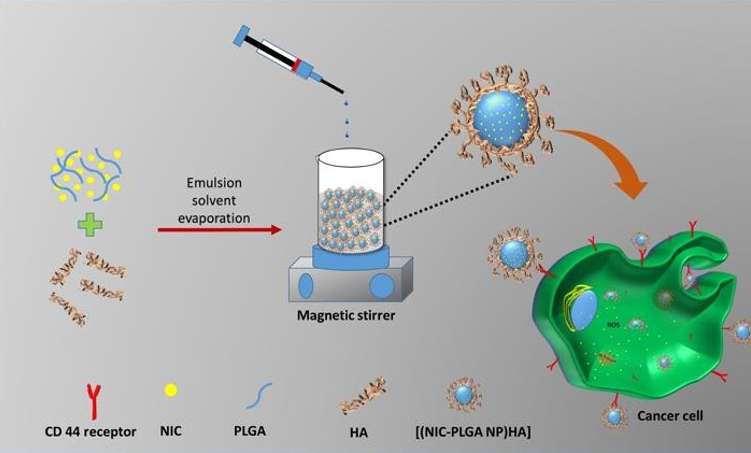The present invention relates to a process for preparing hyaluronic acid functionalized PLGA nanoparticles for localized cancer nanomedicine. The process of the present invention is cost effective, uses readily available biomaterials and workable in a facile one pot strategic approach. The present invention also provides hyaluronic acid functionalized PLGA nanoparticles for localized cancer nanomedicine.
Cancer remains a life-threatening disease due to the uncontrolled proliferation and spread of malignant cells, with no universally effective treatment protocol. Conventional therapies often fail to address individual variability in metabolism, immune response, and drug interactions, leading to limited efficacy and severe side effects. While nanotechnology offers promising solutions through targeted drug delivery, current nanocarriers face significant challenges such as complex synthesis, high costs, low yield, poor cellular uptake, and limited therapeutic performance.
There is an urgent need for a novel, efficient, and cost-effective nanocarrier system that can selectively target cancer cells, enhance drug delivery, and overcome existing limitations in cancer pharmacotherapy.
- Enhanced Targeting via Surface Modification: Surface modification of PLGA nanoparticles with hyaluronic acid improves active targeting of cancer cells, especially those overexpressing CD44 receptors, leading to higher therapeutic precision.
- Overcomes Limitations of Conventional PLGA Nanoparticles: The invention addresses key drawbacks of PLGA such as poor colloidal stability, low drug loading, and slow degradation by enhancing stability, morphology control, and cellular uptake.
- Cost-Effective Drug Repurposing: It Incorporates niclosamide, a low-cost, FDA- approved anthelmintic drug with strong anti-cancer properties, offering an affordable alternative to conventional chemotherapeutics.
- Multi-Pathway Cancer Suppression: Niclosamide blocks multiple key cancer-related signalling pathways (STAT3, Wnt/β-catenin, mTORC1, NF-κB, Notch), enabling broad-spectrum anti-cancer action and reducing tumor resistance.
- Efficient One-Pot Synthesis Method: The nanoparticle system is synthesized using a simple, scalable one-pot process, reducing complexity, time, and cost compared to conventional multi-step nanoparticle fabrication methods.
- High Therapeutic Potential and Tumor Suppression: The formulation enables effective delivery of niclosamide to tumor sites, resulting in complete tumor suppression and prevention of metastasis to secondary sites.
The process begins by dissolving PLGA and a hydrophobic drug in an organic solvent to form the organic phase. This is added dropwise into an aqueous solution containing 0.25–2% w/v PVA under continuous stirring to create an emulsion. The emulsion is then sonicated and stirred further to allow evaporation of the organic solvent, forming a nanoparticle dispersion. To this dispersion, 0.01–0.2% w/v hyaluronic acid (HA) is added into the aqueous phase. The HA functionalizes the surface of the nanoparticles with the help of PVA as a surfactant. The resulting HA-functionalized PLGA nanoparticles have sizes ranging from 100 to 500 nm and are suitable for localized cancer nanomedicine applications.
Currently at TRL 3 – proof of concept stage, with further development underway.
3
The invention presents a cost-effective and biocompatible nanotherapeutic platform that can make advanced cancer treatment more accessible and affordable. By repurposing an existing FDA-approved drug, it reduces the burden of drug development costs. Its targeted delivery approach minimizes side effects, improving patients’ quality of life. Overall, it supports more equitable and safer cancer care solutions.
- Nanomedicine and drug delivery
- Oncology and cancer therapeutics
- Pharmaceutical research and development
- Biomedical nanotechnology
- Targeted therapy platforms
- Biocompatible materials engineering
- Personalized medicine
Geography of IP
Type of IP
202021032490
457044

